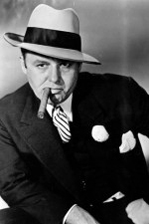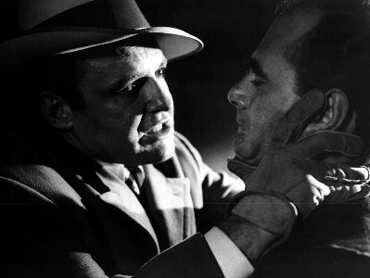
 |
|
|
|
Thanks to the paternalistic dictums of the Production Code, the gangster genre's ability to offer truthful comment on American crime dropped more or less to zero for most of the 1930s and 1940s. It didn't really spring back to life until the early 1950s with the increased public and governmental focus on organized crime. Before that, the depiction of gangsters was so tightly restricted that nothing realistic got through to movie screens. Many American towns and cities were corrupt and plenty were run by organized crime to some degree. Yet the movies still behaved as if gangsters were rogue rotten apples easily disposed of when civic-minded citizens banded together. The famous-name gangsters of the 20s and 30s became celebrities thanks to the F.B.I., which needed villains to make J. Edgar Hoover look like a big hero. John Dillinger, Legs Diamond and Bonnie & Clyde ended up as legends around which circulated clouds of apocryphal stories. Punks like George "Machine Gun Kelly" and Vincent "Mad Dog" Coll became mythological figures, even though their real significance was next to nil. It wasn't until 1945 that someone dared break the Code and portray a "real" gangster in a movie by name, in Philip Yordan's Dillinger. But the events of that movie had almost nothing to do with the real criminal's career. 
In the second half of the 1950s came a wave of gangster exposés, often named after the "big boys" -- Budd Boetticher's The Rise and Fall of Legs Diamond,, Roger Corman's Machine Gun Kelly, etc. These would eventually coalesce into a faux-docudrama format, often with a 'voice of the city' narration. Americans not prone to attend gangster movies got their fill on TV's The Untouchables, which told a fairy-tale version of the cleaning up of Chicago by federal agent Eliot Ness, narrated by the Voice of Broadway, Walter Winchell. Al Capone is a fairly faithful biopic of America's most famous gangster, a racketeer so powerful that at one time he had all of Chicago in his pocket and exerted influence in other cities like Detroit and St.Louis. Capone's name became synonymous with the failure of law and order during Prohibition. The script by Malvin Wald and Henry F. Greenberg sticks mostly to known facts. Wald had written a string of films noir in the previous decade, including the classic The Naked City, and the film crackles with good dialogue. If anything, the violence is underplayed -- the performance of powerhouse method actor Rod Steiger makes most of it unnecessary. As Capone, Steiger dominates almost every scene. A very good makeup scar (it's remarkably consistent throughout the film) adds to the sense of menace too. Brooklynite Alphonse Capone (Steiger) comes to Chicago to serve as a bouncer for his pal Johnny Torrio (Nehmiah Persoff of Yentl) and soon crosses paths with Police Sgt. Schaefler (James Gregory of The Manchurian Candidate), whose hands are tied by the mob's systematic payoffs. Fearing the power of Torrio's competition Dion O'Bannion (Robert Gist), Earl "Hymie" Weiss (Lewis Charles) and George "Bugs" Moran (Murvyn Vye), Al convinces Johnny to murder their revered boss Big Jim Colosimo (Joe De Santis). Thus begin eight years of bloody internecine warfare in the rackets. Meanwhile, Al woos and marries Maureen Flannery (Fay Spain of Hercules and the Captive Women), the widow of a man slain with Big Jim. She does so after Al swears that he had nothing to do with her husband's death. But the game changes as reform candidates get traction, Schaefler rises in the police force and the Feds get involved. Corrupt reporter (Mac Keeley) Martin Balsam, a frequent paid advisor and negotiator for Al, begins to get cold feet. After the St. Valentine's Day Massacre, things begin to fall apart for Al Capone. 
Al Capone is one of the best of the 'biographical' gangster pix; those who don't like it usually can't abide Rod Steiger's performance. After fifty years of crazy acting styles Steiger now looks relatively restrained, and when he does thrash wildly about the screen, he's at least in character. Capone supposedly did throw volcanic tantrums, some of which were just for effect, and others that can only be chalked up to blind fury. The two actual killers in the St. Valentine's caper are shown to be murdered soon after by Moran's mob; in actuality Capone killed them himself, later, apparently ritually beating them to death with a club. The film abounds with tough guys and ugly-mugs giving good performances, possibly cued by Steiger's presence. The script and playing emphasize the ethnic origins of the Irish O'Bannion and the various Italian mobsters, to the point that none other than Frank Sinatra complained about defamation, to gangster shows in general and TV's The Untouchables in particular. The movie doesn't know what exactly to do with Earl "Hymie" Weiss, who was a Polish Catholic. The character gets less screen time. The Allied Artists film puts some good production value on screen, with plenty of detailed sets and some elaborate back lot work. For the famous moment when Capone's enemies try to machine-gun him in a candy shop, one view looks out the store's shattered plate glass window to see an entire street with vintage cars in the background. Cameraman Lucien Ballard gives the show a consistent look, with gray on gray daytime scenes and night scenes dominated by inky black corners. Costuming is reasonable -- we see the obligatory scene where Al is outfitted in his first fancy suit -- but some of the ladies' hairstyles look more like 1959 pony-tails than 1920s bobs and shellac'ed helmets. Director Richard Wilson was an early associate of Orson Welles and plays a role in Citizen Kane; he also wrote some of his own films and became outspoken about the mangling of his 1964 picture Invitation to a Gunfighter. 1 Wilson's work here is effective and mostly unobtrusive, finding good ways to display the character drama and underlining the violence with camera moves. The Valentine's Massacre features a nice trucking shot behind the victims as they're gunned down; Roger Corman would use the same shot as the center of a much longer sequence in his later The St. Valentine's Day Massacre. Wilson also has a knack for iconic compositions. The murder of Dion O'Bannion is accomplished by a hood who shakes his hand and doesn't let go while his friends shoot their victim at point blank range. An angle of machine-gunners raking the candy store looks like a firing line at a rifle range, with one photogenic hood gritting his teeth in profile. Al Capone is a solid show but not a genre watershed or a movie with big revelations about crime in America. It was made at a time when the facts of the 20's hoods weren't generally known and could still shock audiences ... but only so far. Al talks about the easy women his power and wealth can afford, but he's relatively chaste in his behavior. The narrator tells us that Al was released from prison for failing health and died later, but not that he was felled by syphilis. That would still be too extreme for a film released in 1959. 
The Warner Archive Collection DVD-R of Al Capone is one of their very first releases, and it comes in a very good enhanced B&W transfer with a strong soundtrack to showcase David Raksin's punchy score. Rod Steiger's name must have helped the film do good business, because the Allied Artists trailer (included as an extra) is no winner -- it makes the movie look like a cheap exploitation picture. Good or bad, the movie played constantly on television for the next twenty years. If it weren't for the effective TV portrayal of Al Capone by actor Neville Brand, Rod Steiger would be more strongly associated with the role.
On a scale of Excellent, Good, Fair, and Poor,
Al Capone rates:
Footnote:
1. I read about Wilson's troubles while researching Major Dundee; the same British art-film critics that rushed to Sam Peckinpah's defense took Wilson's side against his producer. But back in the 1960s nobody knew or cared if a director lost control of his picture ... and Wilson's career is said to have suffered because of his 'troublemaking'.
Reviews on the Savant main site have additional credits information and are often updated and annotated with reader input and graphics. Also, don't forget the 2010 Savant Wish List. T'was Ever Thus.
Review Staff | About DVD Talk | Newsletter Subscribe | Join DVD Talk Forum |
| ||||||||||||||||||